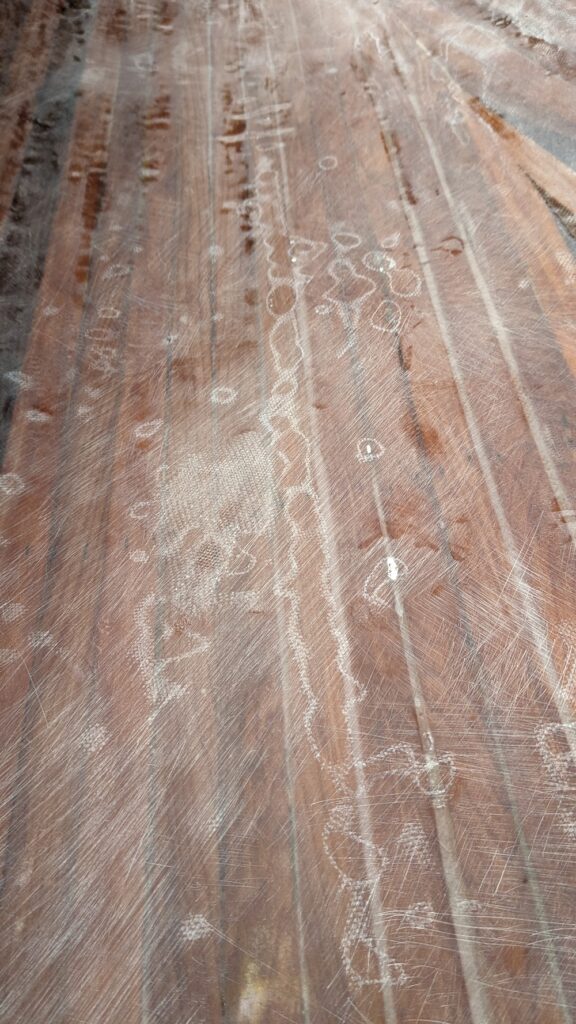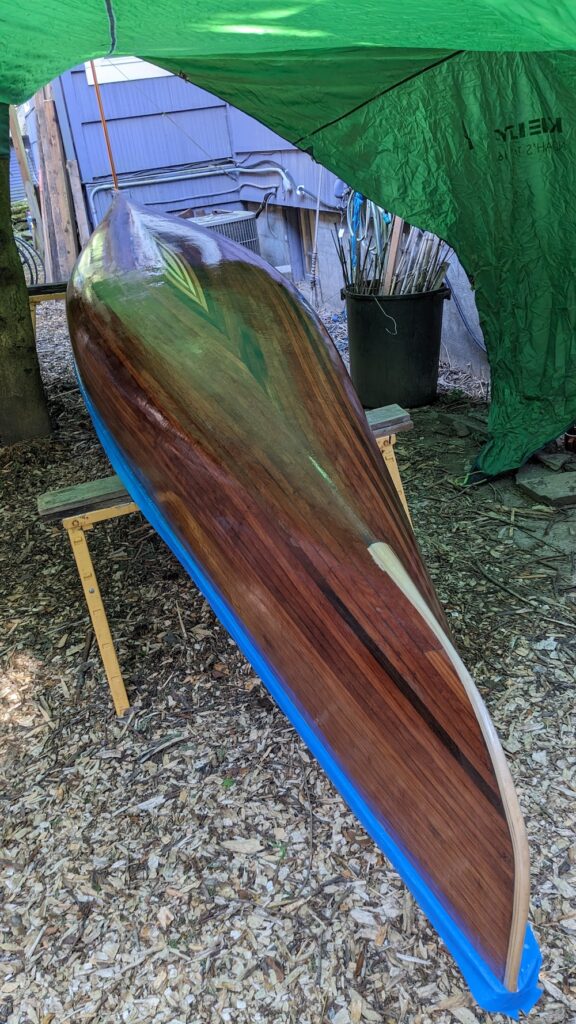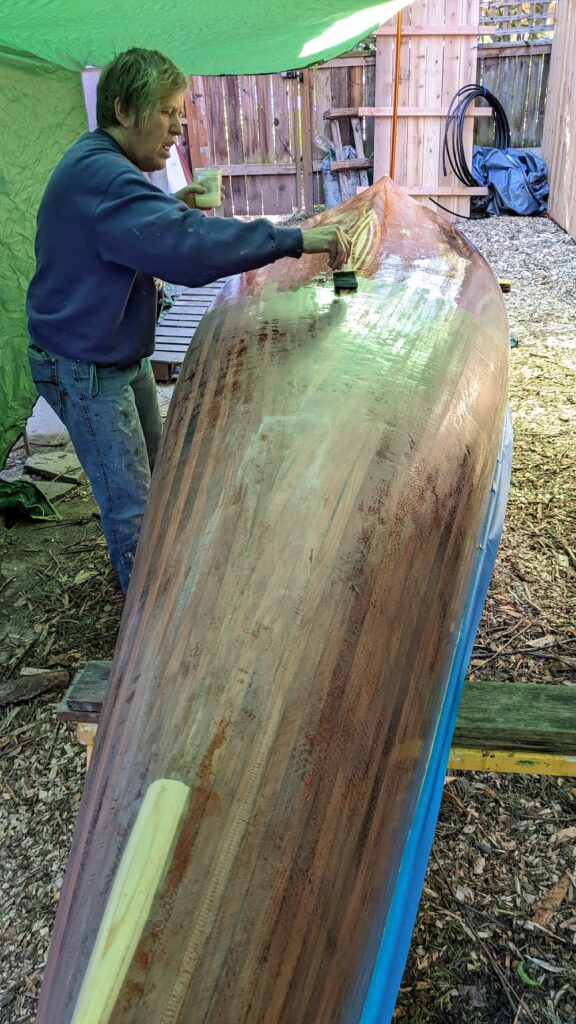
Epoxy scares me. Once you brush it on, you’ll never be able to get it off. Epoxy is like breaking an egg; once you start, you can’t put it back. There is no command-Z undo with epoxy.
Even if you were to remove the epoxy-saturated fiberglass, epoxy would have already seeped into the wood to a depth that cannot be sanded away. We traveled to Port Townsend to get help to do it correctly the first time..
Epoxy and fiberglass are great compared to aluminum, canvas, primer and paint, but leave epoxy exposed to the ultra-violet rays in sunlight and it turns yellow and breaks down into dust. Epoxy needs to be protected from sunlight.
Varnish is the ticket…

“Nothing in life is to be feared. It is only to be understood”
Marie Curie
I work to desensitize my fears. I have a fear of needles, so I’ve committed to giving blood. I have a fear of drowning, so I’ve learned to roll a kayak. I don’t need to fear epoxy if I know more about it.
Chemistry

Epoxy is chemical goop used to saturate fiberglass cloth. By mixing a catalyst with epoxy resin, it forms chemical chains with itself, hardening and providing benefits like adhering fiberglass to a cedar strip canoe. It’s the same stuff as two-part five-minute epoxy used to repair things in your house, only in larger quantities and with a set time of hours instead of minutes.
Once brushed into fiberglass, epoxy saturates the cloth, then seeps into the pores of the wood. It’s a canoe sandwich, with a layer of wood between two slices of fiberglass, slathered with a generous dressing of resin.
First patented in 1946, epoxy started the transition from wood and canvas canoes coated with filler and paint to cedar strip, ABS, and aluminum canoes. With each of these changes, boats became lighter and more resilient. Our Seliga wood-and-canvas canoe weights close to seventy-five pounds. Our cedar strip weighs forty-seven. The two boats represent techniques available when the boat was manufactured.
UV Protection
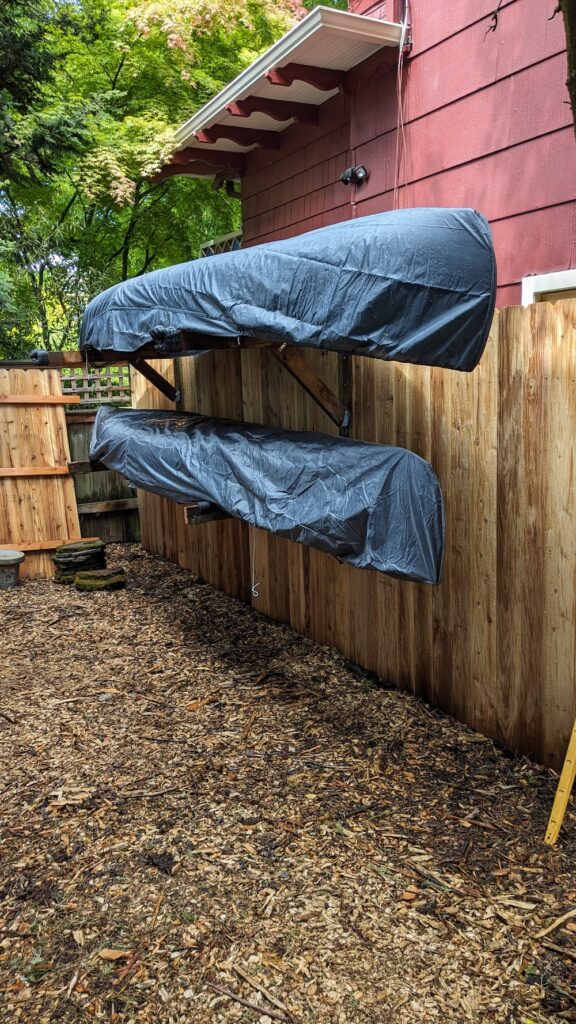
Some folks store their boats in a shed or their garage. We have neither, so Janell sewed up a fabric cover for the boat; we’ll use it in-between paddles. But when the boat is on the water, it needs something to protect it.
Varnish provides UV protection. But not just any varnish. Manufacturers design some varnish for indoor use, some for external use, and some for marine situations. External marine varnish is called “spar varnish.”
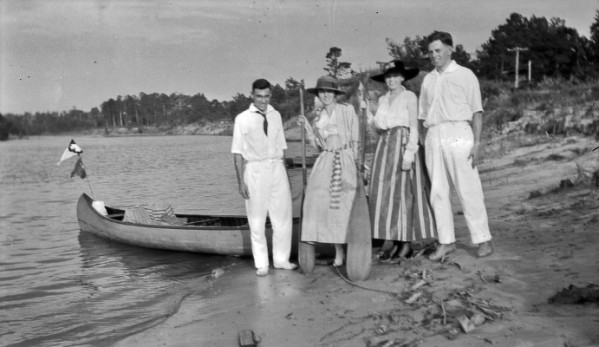
Varnish isn’t just for epoxy. Paddles get a beating, and as much as I lecture about paddles not being shovels, they still get scuffed on rocks, ground into sand beaches, and stuffed into boats on portages. Those gouges need to be sanded until smooth. Start with 80 grit to work out the gouges, then move to 120 for a nice feel. 220 grit if you are in the mood. Then apply varnish to protect the wood from water.
It’s not just paddles; It’s also yokes, thwarts, and seats. And don’t forget protecting epoxy, which we’ll bring up again in a minute.

Paddles aren’t boards. Lay a paddle flat, spread varnish on it, and the varnish pools and makes a big mess. Better to put a small eye-screw in the handle, then hang it from a tree branch or overhead beam. Place some newspaper on the ground to catch drips, then apply varnish starting from the handle, moving downwards to the blade at the lowest end. If the varnish doesn’t dry too quickly, it will smooth out as it runs down, with the excess dripping onto the paper without globbing up on the paddle.
I learned to mix varnish with mineral spirits for a smooth first coat. This allows it to saturate the pores of the wood and quickly run off the paddle. Wait for it to dry, sand with 120 grit sandpaper and put on another coat of full strength varnish. Wait, sand, varnish. Some craftsmen believe in doing this seven or more times.
I enjoy maintaining paddles. It’s a slow rhythm of tasks I can fit in between spurts of monkey-brain. Sand…varnish…attend to busy box while varnish dries…light sand…varnish…attend to busy box. It’s akin to paddling on a still lake when the rhythm of paddle strokes gives monkey-brain something to do while the rest of your brain appreciates the scenery.
When I varnish over epoxy, I start with full strength. It is easy to apply. At the right temperature and humidity, it will dry and be ready for another coat within an hour. I am careful about brushing out drips so I don’t have to sand between coats.
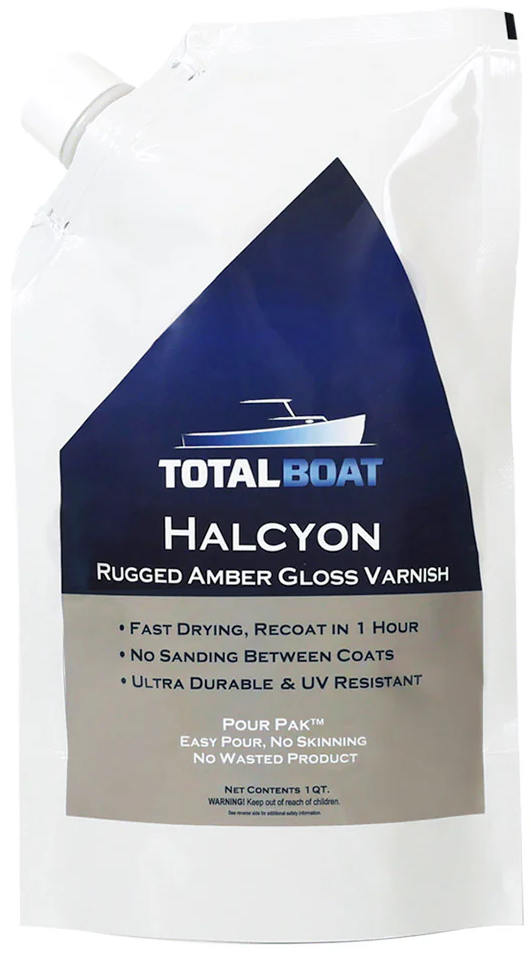
Rich mentioned Halcyon marine varnish from TotalBoat. (I’m not being reimbursed for a product placement). It’s water-based for easy clean-up and no odor; best of all, it comes in a flexible container with a pour spout and resealable cap. Varnish in a can eventually skins over and dries into a solid, plastic block. Ick.
Varnish comes in two finishes; gloss and satin. Many of the cedar strip boats I’ve seen use a high-gloss varnish; Janell and I prefer the muted finish provided by satin varnish. It looks more like a piece of furniture. But satin varnish clouds up with multiple coats. I brush on three coats of gloss, followed by one coat of satin.
Finish…line
With a layer of varnish, the boat will be ready to affix yokes, thwarts, and seats. Then…Janell and I will find out if it actually floats!
